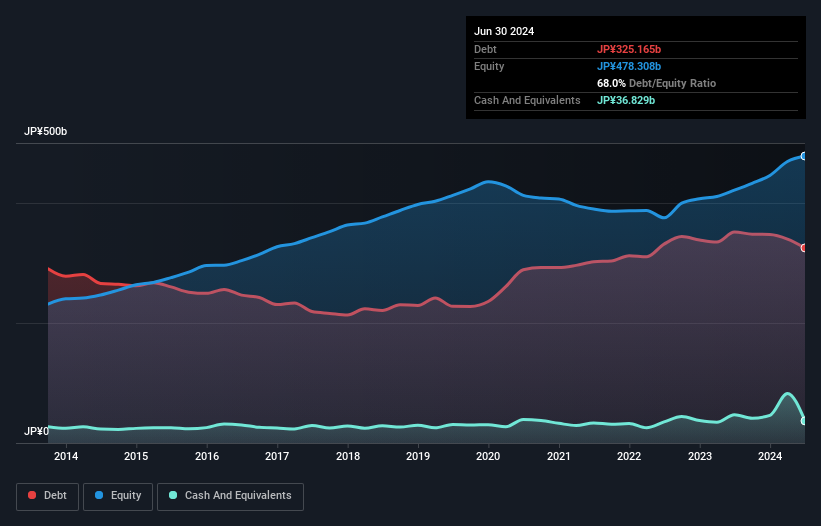- Japan
- /
- Transportation
- /
- TSE:9009
Here's Why Keisei Electric Railway (TSE:9009) Can Manage Its Debt Responsibly
Howard Marks put it nicely when he said that, rather than worrying about share price volatility, 'The possibility of permanent loss is the risk I worry about... and every practical investor I know worries about.' So it might be obvious that you need to consider debt, when you think about how risky any given stock is, because too much debt can sink a company. As with many other companies Keisei Electric Railway Co., Ltd. (TSE:9009) makes use of debt. But is this debt a concern to shareholders?
When Is Debt Dangerous?
Debt is a tool to help businesses grow, but if a business is incapable of paying off its lenders, then it exists at their mercy. Part and parcel of capitalism is the process of 'creative destruction' where failed businesses are mercilessly liquidated by their bankers. However, a more common (but still painful) scenario is that it has to raise new equity capital at a low price, thus permanently diluting shareholders. Of course, plenty of companies use debt to fund growth, without any negative consequences. When we think about a company's use of debt, we first look at cash and debt together.
View our latest analysis for Keisei Electric Railway
How Much Debt Does Keisei Electric Railway Carry?
You can click the graphic below for the historical numbers, but it shows that Keisei Electric Railway had JP¥325.2b of debt in June 2024, down from JP¥351.5b, one year before. On the flip side, it has JP¥36.8b in cash leading to net debt of about JP¥288.3b.

How Strong Is Keisei Electric Railway's Balance Sheet?
We can see from the most recent balance sheet that Keisei Electric Railway had liabilities of JP¥182.1b falling due within a year, and liabilities of JP¥356.6b due beyond that. On the other hand, it had cash of JP¥36.8b and JP¥31.2b worth of receivables due within a year. So it has liabilities totalling JP¥470.6b more than its cash and near-term receivables, combined.
This deficit is considerable relative to its market capitalization of JP¥703.8b, so it does suggest shareholders should keep an eye on Keisei Electric Railway's use of debt. This suggests shareholders would be heavily diluted if the company needed to shore up its balance sheet in a hurry.
We measure a company's debt load relative to its earnings power by looking at its net debt divided by its earnings before interest, tax, depreciation, and amortization (EBITDA) and by calculating how easily its earnings before interest and tax (EBIT) cover its interest expense (interest cover). Thus we consider debt relative to earnings both with and without depreciation and amortization expenses.
Keisei Electric Railway's net debt is 4.5 times its EBITDA, which is a significant but still reasonable amount of leverage. However, its interest coverage of 15.6 is very high, suggesting that the interest expense on the debt is currently quite low. Pleasingly, Keisei Electric Railway is growing its EBIT faster than former Australian PM Bob Hawke downs a yard glass, boasting a 106% gain in the last twelve months. There's no doubt that we learn most about debt from the balance sheet. But ultimately the future profitability of the business will decide if Keisei Electric Railway can strengthen its balance sheet over time. So if you want to see what the professionals think, you might find this free report on analyst profit forecasts to be interesting.
Finally, a company can only pay off debt with cold hard cash, not accounting profits. So it's worth checking how much of that EBIT is backed by free cash flow. Looking at the most recent two years, Keisei Electric Railway recorded free cash flow of 30% of its EBIT, which is weaker than we'd expect. That's not great, when it comes to paying down debt.
Our View
Keisei Electric Railway's interest cover was a real positive on this analysis, as was its EBIT growth rate. But truth be told its net debt to EBITDA had us nibbling our nails. When we consider all the factors mentioned above, we do feel a bit cautious about Keisei Electric Railway's use of debt. While we appreciate debt can enhance returns on equity, we'd suggest that shareholders keep close watch on its debt levels, lest they increase. The balance sheet is clearly the area to focus on when you are analysing debt. However, not all investment risk resides within the balance sheet - far from it. For example Keisei Electric Railway has 3 warning signs (and 2 which are potentially serious) we think you should know about.
At the end of the day, it's often better to focus on companies that are free from net debt. You can access our special list of such companies (all with a track record of profit growth). It's free.
Valuation is complex, but we're here to simplify it.
Discover if Keisei Electric Railway might be undervalued or overvalued with our detailed analysis, featuring fair value estimates, potential risks, dividends, insider trades, and its financial condition.
Access Free AnalysisHave feedback on this article? Concerned about the content? Get in touch with us directly. Alternatively, email editorial-team (at) simplywallst.com.
This article by Simply Wall St is general in nature. We provide commentary based on historical data and analyst forecasts only using an unbiased methodology and our articles are not intended to be financial advice. It does not constitute a recommendation to buy or sell any stock, and does not take account of your objectives, or your financial situation. We aim to bring you long-term focused analysis driven by fundamental data. Note that our analysis may not factor in the latest price-sensitive company announcements or qualitative material. Simply Wall St has no position in any stocks mentioned.
About TSE:9009
Keisei Electric Railway
Engages in the provision of public railway transportation services for local communities in Japan.
Fair value with low risk.
Market Insights
Community Narratives



